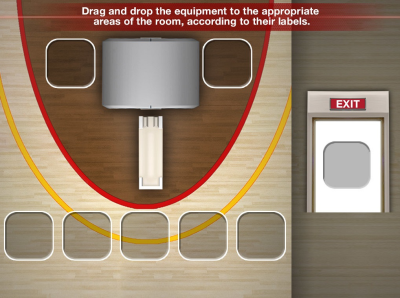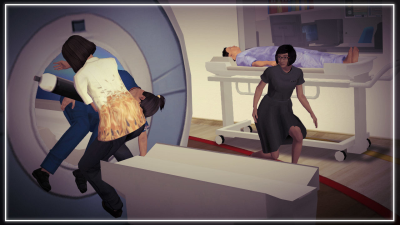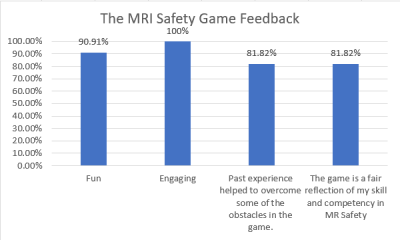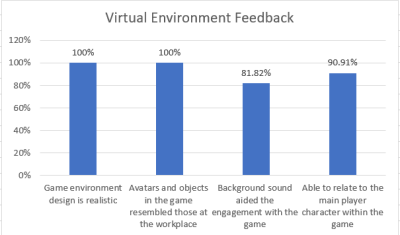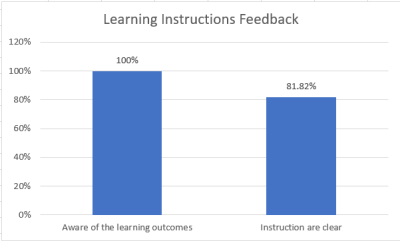5051
Gamified Learning in MRI Safety1Neuroradiology, National Neuroscience Institute, Singapore, Singapore
Synopsis
Magnetic Resonance (MR) safety plays an important role in ensuring patients and staff safety and is important for all staff to be competent prior to working in the MRI environment. To make MR safety training more engaging and motivated, game-based learning was adopted to simulate situations that are dangerous and impossible to re-enact in the real world. Learner acts as avatar and explore the MR safety concepts through a 3D version of the National Neuroscience Institute (NNI), Neuroradiology department. Learner will identify hazards through mini-games and role-play as Chief Risk Officer to identify gaps from a MR related accident
Introduction
Magnetic Resonance (MR) safety plays a critical role in any Radiology Department to ensure the safety of patients and healthcare workers. MR safety lapses can be deadly, and serious games can virtually replicate the MR environment and simulate MR incidents that are too dangerous to re-enact in the real world, thus preparing the healthcare professionals for such scenarios. The gamified MRI safety education is to allow healthcare workers to gain knowledge of MR safety and accident risk management, and to be able to demonstrate understanding of these concepts by application of knowledge in the application scenarios within the game and at the workplace. The target audience for this game includes radiology staff, healthcare staff or ancillary staff, such as housekeeping personnel, who may enter the MR environment and thus, are required to ensure MR safety in their line of work.Methods
Partnering with game developer, the game was designed to set out in a virtual radiology department, modelled after the Neuroradiology department at the National Neuroscience Institute. The virtual world includes patients, staff and medical devices that mirror real-life equipment in the radiology department. Two games were created in the MR safety series. In the first game, learners navigate as an avatar to interact with objects in the MR environment, such as medical devices and virtual patients. The learning outcome of the first game is to understand the key MR safety concepts which follow the American College of Radiology (ACR) guidelines (American College of Radiology, 2020). The second game was modelled on an MR-related accident. Learners assess the accident and consider strategies for risk management, evaluating their options within the game. Critical wrong decisions or actions made during the gameplay may trigger an abrupt end to the game. This emphasizes the urgency of actions required in an MR-related accident when a life is in danger and the immediate steps required to be taken to reduce the risk for further injuries. Beyond the virtual accident, the trainee role-plays as a Risk Officer to assess and identify the root causes that led to the accident. Mini-games are used as formative assessments, and trainees receive instantaneous in-game feedback. Trainees are also required to screen virtual patients and place medical devices in their appropriate location, as part of the MR safety screening checks which allowed the assessment of their ability to identify hazards in and around the MR environment.Results
Preliminary testing of the game was conducted on eleven staff including radiographers, radiologists, radiography assistants, radiology nurses and administrative staff with differing years of MR work experience. Data reported below as ‘agreed’ is aggregated to reflect ‘agreed’ and ‘strongly agree’ responses. (Cheng et al., 2021) In terms of the learning instructions, all respondents (100%) were aware of the learning outcomes. 81.82% found the instructions clear, and they knew what to do at every stage. In terms of the virtual game environment, respondents generally felt the game has realistic engagement regarding the design. All respondents (100%) agreed that the game environment was realistic; the avatars (player characters) and objects in the game resembled those at the workplace (100%), and the background sound aided the engagement with the game (81.82%). 90.91% of respondents could also relate to the main player character within the game. On the contrary, some respondents had trouble operationalizing the game mechanics; 27.27% had trouble using the controls, and 36.36% found it difficult navigating within the game. Overall, 90.91% found the game was fun, and engaging (100%). 81.82% agreed that their past experience helped them to overcome some of the obstacles in the game. Furthermore, 81.82% agreed that the results are a fair reflection of their skill and competency in MR safety.Conclusion
Purpose-built simulation serious games that mimic a virtual radiology department provide an ideal training solution for MR safety education. Serious games provide an immersive learning environment where simulated scenarios such as safety screening of virtual patients and MR-related accidents is made possible. Simulation of dangerous scenarios that are impossible to recreate in the real world provides opportunities to raise MR safety awareness and is also scalable to the wider healthcare community.Acknowledgements
We would like to thank Singhealth Academy and Playware Studios for their tremendous contribution for the creation of this serious game. We are also thankful to NNI neuroradiology staff for their help with the pre-testing of the game, contributing to the game development through honest feedback. We are thankful to Serious Games Asia and Singapore University of Technology and Design (SUTD) for co-developing the survey evaluation. We sincerely thank our scale-up teams the radiology departments from Singapore General Hospital (SGH), Sengkang General Hospital (SKH) and KK Women’s and Children’s Hospital (KKH) so that more staff across SingHealth can benefit from MR safety training through this serious game.References
1. American College of Radiology. (2020). ACR manual on MR safety. https://www.acr.org/-/media/ACR/Files/Radiology-Safety/MR-Safety/Manual-on-MR-Safety.pdf
2. Cheng, Q., Ti, J. P., Yu, W.-Y., Oh, H. P., & Sitoh, Y. Y. (2021). MR safety beta testing data. https://doi.org/10.6084/m9.figshare.14473074.v1
